This week, read about inactivity in kids, why sugar is not the enemy, how wearable tech is changing exercise research, why saturated fat matters, and more.
 Physical Activity in Canadian Kids is Alarmingly Low. The 2014 Report Card on Physical Activity for Children and Youth was released this week. This year’s report looked at how Canadian youth compared to 14 other countries and revealed that although Canada has a well-developed physical activity infrastructure and programs, Canadian kids are at the back of the global pack for overall physical activity levels. Physical activity in youth is alarming low, with only 5% of 5- to 17-year-olds meeting the Canadian Physical Activity Guidelines (being active for 60 minutes a day). New Zealand and Mozambique were the most active countries, with kids reporting 78 minutes/day of physical activity.
Physical Activity in Canadian Kids is Alarmingly Low. The 2014 Report Card on Physical Activity for Children and Youth was released this week. This year’s report looked at how Canadian youth compared to 14 other countries and revealed that although Canada has a well-developed physical activity infrastructure and programs, Canadian kids are at the back of the global pack for overall physical activity levels. Physical activity in youth is alarming low, with only 5% of 5- to 17-year-olds meeting the Canadian Physical Activity Guidelines (being active for 60 minutes a day). New Zealand and Mozambique were the most active countries, with kids reporting 78 minutes/day of physical activity.
Although some blame parents, a solution likely lies in a combination of efforts at all levels – individual, interpersonal, organizational, community, and public policy. More info: Report Highlights; Tips to increase your kids’ physical activity levels, 2014 Report Card on the Physical Activity of Children and Youth.
Is it the Electronics? On the same theme this week, Finnish researchers linked low levels of physical activity combined with heavy use of electronic media and sedentary behaviour to an increased risk for type 2 diabetes and vascular diseases in 6- to 8-year-old children (yikes!). Another study in the journal noted significant correlations between parent and child screen time. Time for kids (and adults) to get away from the screens and play. (International Journal of Behavioral Nutrition and Physical Activity, May 2014).
 Sugar is Not the Enemy (especially for active people). Most people eat too much added sugar, and recent guidelines highlight the health effects of this habit. Some wonder if this overemphasis on one nutrient is overshadowing the large problem of inactivity. In fact, bodies that move are much better equipped to handle sugars: when diabetics exercise, they require less insulin to control their blood sugar; endurance athletes rely on sugar to fuel fast performances (here’s an example of the sugars a world record marathoner would ingest during an event). Although most of us aren’t running marathons (certainly not at that speed), exercise might mitigate the undesirable effects of sugar (David Despain, Outside Magazine).
Sugar is Not the Enemy (especially for active people). Most people eat too much added sugar, and recent guidelines highlight the health effects of this habit. Some wonder if this overemphasis on one nutrient is overshadowing the large problem of inactivity. In fact, bodies that move are much better equipped to handle sugars: when diabetics exercise, they require less insulin to control their blood sugar; endurance athletes rely on sugar to fuel fast performances (here’s an example of the sugars a world record marathoner would ingest during an event). Although most of us aren’t running marathons (certainly not at that speed), exercise might mitigate the undesirable effects of sugar (David Despain, Outside Magazine).
Wearable tech is changing exercise research. Much of physical activity research has relied on questionnaires and self-report to monitor exercise. A trend to using more objective measures (e.g., accelerometers) will certainly help provide better information and more accurate results (unfortunately, by necessity, most nutrition science still relies on self-report). (Live Science).
Saturated or not: Does type of fat matter? Experts in the field are worried that recent media coverage sensationalizing results of a study on saturated fats could be detrimental to public health. Check out this link to view the interpretation of a panel of nutrition experts (Harvard School of Public Health).
Healthy or Hype? Coconut Oil. Find out if coconut oil lives up to the health claims and hype in my new series.
Olive Oil Does Your Salad Good. We are learning more and more about why nitrate-rich vegetables are good for us, and how they might improve athletic performance. This new study highlights benefits of the perfect culinary combo – olive oil and leafy greens! (Proceedings of the National Academy of Sciences)
Roasted Potato Salad with Vegetables. Perfect for a weekend BBQ – nutritious, with plenty of flavor. (would be good with arugula->nitrate-rich veggie).
See more Weeks in Food, Health, and Fitness
Share This: